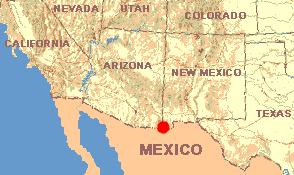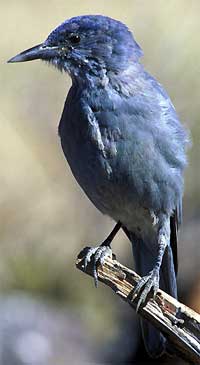 March 2,
1988
March 2,
1988NEW MEXICO: Hidalgo County
Coronado National Forest three miles east of the Arizona border and fifteen miles north of the Mexican border, in the Peloncillo Mountains. Elevation between 6000 and 7000 feet.
 March 2,
1988
March 2,
1988Weeh, weeh, weeh!
 Henry is fixed so
that I can sleep in him. His entire back seat and the passenger-side front seat have been
removed, so when it's too cold to sleep outside I use my inside bed. I have a board placed
from near the top of the engine compartment in the rear to the top of a metal milk-crate
situated where a passenger's feet would be if ever I carried passengers. I sleep in Henry
quite comfortably.
Henry is fixed so
that I can sleep in him. His entire back seat and the passenger-side front seat have been
removed, so when it's too cold to sleep outside I use my inside bed. I have a board placed
from near the top of the engine compartment in the rear to the top of a metal milk-crate
situated where a passenger's feet would be if ever I carried passengers. I sleep in Henry
quite comfortably.
Weeh, weeh, weeh!
It's those six Mexican Jays again, begging for food even before morning's
sunlight hits mid-slope. It's 23º out there, but those birds think I'm going to leave my
warm sleeping bag just to feed them!
Weeh, weeh, weeh!
I lie with my feet beneath the glove compartment and my face staring straight up through
the back window, watching the birds through curlicues of my breath frozen on the glass.
Weeh, weeh, weeh!
So now those jays start messing on Henry's cab! Funny thing: Instead of hitting with a wet
or soft sound, each dropping kind of clinks when it lands on the cab. OK, you birds win. I
have to see what's going on.
In the droppings I find tiny, white, flat flakes of something hard. Ah, so now I know who
stole the egg shells left yesterday morning next to the campfire! Having solved the
klink-mystery, I start a fire and begin fixing scrambled eggs with jalapeño peppers,
cornbread and a pot of tea. Sitting on a rock, I make sure that those six jays stay away
from over Henry's cab. While eating, I notice some subtle personality differences among
the jays. I wonder whether these differences might become more apparent if I should toss
cornbread crumbs to them?
Within five minutes it's clear that each bird has its own very distinct personality. Moreover, I can divide these birds into three groups according to how they're handling their crumb-getting opportunities.
First, there are two "crumb-getters," who manage to snap up all crumbs to the exclusion of the other four.
Second there are two "robbers" who lack the confidence to fly down near me and nab a crumb themselves, but when a crumb-getter gets one, the robbers chase after it and by hopping near it when it lands, sometimes cause the crumb-getters to relinquish their prize.
Third, there are "hungry whiners." Instead of calling weeh, weeh, weeh, these make a complaining, whining ahh, ahh, ahh. It reminds me of the buzzy, begging sound that some fledglings make when begging their parents for food. In fact, these hungry whiners also flutter their wings when begging, just like begging fledglings. Maybe they are fledglings, despite their size and mature appearance!
A crumb-getter makes off with a big prize and flies away low and fast, making a curious wet-drumhead sound with its wings. About thirty yards away it lands in the grass beneath an Alligator Juniper. The robbers now seem to be sated so they ignore our bird, but one of the hungry whiners flies to a lower bough on the juniper and looks down at our bird. Surprisingly, crumb-getter doesn't eat the crumb --just drops it into the grass, gazes proprietarily at it for a while, and then hops away, nonchalantly flipping small stones and grassblades with its beak, and looking totally unconcerned about the left-behind crumb.
Once crumb-getter is about six feet from the crumb, the hungry whiner drops down beside the prize. However, before the crumb is stolen, crumb-getter is back. Now for a good five seconds both birds simply stand in the grass alternately looking at one another and the crumb.
Finally, almost with an air of exasperation, crumb-getter picks up the crumb and gulps it down.
It's hard not to become anthropomorphic when dealing with birds as spirited as these!